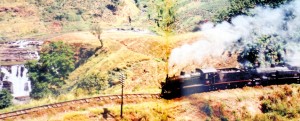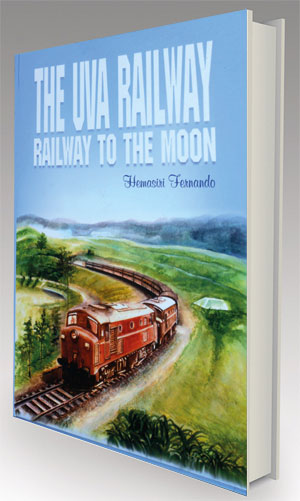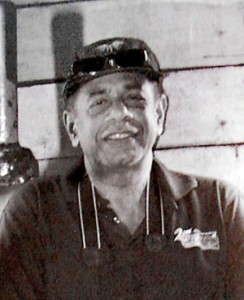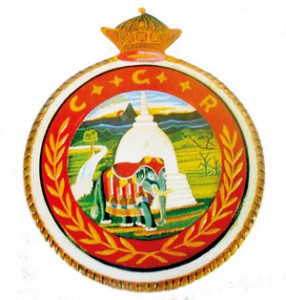A fascinating journey
View(s):Before reviewing this beautifully produced book about the Uva Railway by Hemasiri Fernando, I must declare an interest. It contains a few quotations from my own work “Sri Lanka By Rail” published in the UK in 1994, which was based on articles I wrote about “great little trips by train” in this newspaper 25 years ago.

Steam locomotives on the Uva Railway
That’s when I first met Hemasiri Fernando who was then pioneering the revival of steam locomotive travel with the Viceroy Express tourist train. Fernando is not a railway man, but a distinguished civil servant, currently Chairman of People’s Bank, so this book about his favourite railway is a labour of love. It is distinguished by an evocative cover depicting two diesel electric locomotives of the 1950s (Brush Bagnall M1s) that conveys the essence of rail travel.
In the introduction the author explains how the Uva Railway (that’s the line from Peradeniya to Badulla), came into existence as an extension of the Colombo to Kandy railway. He describes it as “the most fascinating railway line in Sri Lanka winding through the tea country witnessing the sub tropical forests, charming waterfalls and breath-taking scenery.”
The line from Peradeniya Junction to Nawalapitiya via Gampola was opened in 1874. It was extended to Nanu Oya via Talawakelle and Hatton in 1885. The difficult stretch, climbing to a height of 6,226ft (1,897.7m) at the summit at Pattipola, reached Bandarawela in 1894. This became the highest point that any broad gauge railway line in the world has reached. (There are railwaylines at higher altitudes but they are not as wide as broad gauge.) It was not until 1924 that the railway reached Badulla, due to the difficulties that had to be overcome in its construction.
In her foreword to the book, Professor Indrani Munasinghe states that the “railway track from Peradeniya to Badulla is considered to be one of the finest train journeys in the world in terms of engineering marvel.” The “railway to the moon” as the author describes it, is enormously popular with foreign tourists, thousands of whom ride the train between Nanu Oya and Ella each year.
Hemasiri Fernando takes the trouble to explain the various railway gauges and how the broad gauge (5ft 6in) was chosen for the winding trail of 110 miles up through the hills. We learn from this book that the highest (at 6,316ft above sea level) railway station in Sri Lanka was at Kandapola, served by the narrow gauge (2ft 6in)Uda Pussellawa Railway from Nanu Oya to Ragala, until it was closed down in 1948.
There are four passenger trains a day linking Colombo and Badulla but the much loved Podi Menike and the Udarata Menike no longer have traditional rolling stock. They are now operated by what Fernando describes as “unimpressive” Chinese built S12 power sets, with air-conditioned carriages. (For a taste of old time rail travel, train number 1007/8 has the old observation car as well as reserved seats available in two privately managed carriages, operated by the Exporail and Rajadhani companies.)
A chapter is devoted to “The men behind the safety of a mountain railway” those of the “Inspectorate Permanent Way (IPW).” These unsung heroes in the checking of the railway track during the damp chill of the night, is rightly acknowledged. The author gives a list of duties performed by the foot patrollers of the IPW staff. This includes “hot weather patrolling to look out for kinks in rails and imminent buckling” – vital during the extremely high temperatures of recent weeks.
The author writes how, on the single track Uva Railway, the Tyer’s Tablet Instrument exercising the ‘absolute block system’ coupled with semaphore signals, comes under the purview of the station master and the tablet system is installed in his office. He states: “If the relevant instruments are operated and observed by all stake holders such as station master, engine driver and guard, no accident involving passenger or freight train can occur.”

Hemasiri Fernando
Six chapters deal with different sections of the line. Fernando guides the inquisitive reader along the climb of 3,819ft in 54.20km from Galboda to Nanu Oya. Thus we learn that pure drinking water drawn from the well at Galboda station was sent by night mail train in special barrels to Colombo for 19th century colonial governors. Watawala, the next station, records the highest annual rainfall in Sri Lanka.
Where is the longest railway tunnel in this country? It’s two miles from Hatton station, the 614 yards-long Pool Bank Tunnel, Number 14 out of the 43 tunnels on the line. The book is full of these intriguing, if arcane, facts- which makes it riveting reading for the rail enthusiast as well as a heartfelt tribute to the railway’s engineers and builders.
Other chapters give the history of the long-gone Uda Pussellawa Railway, details of the incredible ride from Ambewela to Bandarawela (“one of the world’s greatest trips by train”), the lunar landscape of Idalgashina and lots of details about the summit and tunnel at Pattipola. The remarkable railway civil engineering achievements involved in laying the track from Bandarawela to Badulla are highlighted, with a chapter devoted to the spiral railway “looping the loop” at Demodara and the famous Nine Arch Viaduct at Gotuwala.
The book concludes with annexures listing the bridges, tunnels and dead ends on the line between Peradeniya Junction and Badulla, and also a list of the highest railway lines in the world. There are details of chronological events in the railway’s construction from 1865 to 1924, and details of the locomotives (both steam and diesel) that have operated on the line, as well as many technical drawings.

Emblem of the Ceylon Government Railway
The superb design of the book is occasionally sabotaged by lack of consistency in spelling, with both US and UK English spellings appearing, sometimes in the same sentence such as the one where “center” is close to “neighbour.” The are a few typos too (sleeparette? Vegetarian instead of vegetation) and some photo captions are clearly inaccurate. A plan for a grandiose dining room for Nanu Oya station is stated to be “dinning [sic] room at the Nawalapitiya station.” Many small black and white photographs such as fittings on the railway track have no captions so it is not clear what is being illustrated. However, other photographs, such as the double spread colour pictures, are magnificent.
Quibbles are minor given the amount of fascinating information contained in this handsome and well produced volume. Hemasiri Fernando is to be congratulated for turning his lifelong passion for Sri Lankan railways into an enchanting and engrossing book.
| Book facts“The Uva Railway – Railway to the Moon”by Hemasiri FernandoISBN 978-955-44167-1-0)Price: Rs 1,500 Reviewed by Royston Ellis |


